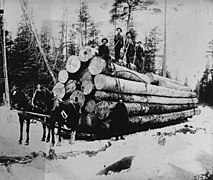

A cant hook or pike or a hooked pike is a traditional logging tool consisting of a wooden lever handle with a movable metal hook called a dog at one end, used for handling and turning logs and cants, especially in sawmills. A cant dog has a blunt end, or possibly small teeth for friction.
A peavey or peavey hook is similar but has a spike in the working end of the handle.[1] Many lumberjacks use the terms interchangeably. A peavey is generally from 30 to 50 inches (0.76 to 1.27 metres) long. The spike is rammed into a log, then a hook (at the end of an arm attached to a pivot a short distance up the handle) grabs the log at a second place. Once engaged, the handle gives the operator leverage to roll or slide or float the log to a new place. The peavey was named for blacksmith Joseph Peavey of Maine who invented the tool as a refinement to the cant hook in the late 1850s.[2] The Peavey Manufacturing Co. is still located in Eddington, Maine, and manufactures several variations. From early times to about 1910, the peavey was written about with various spellings such as "pevy" and "pivie".






